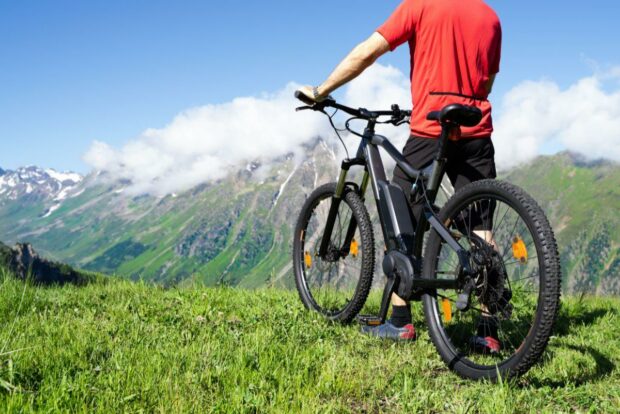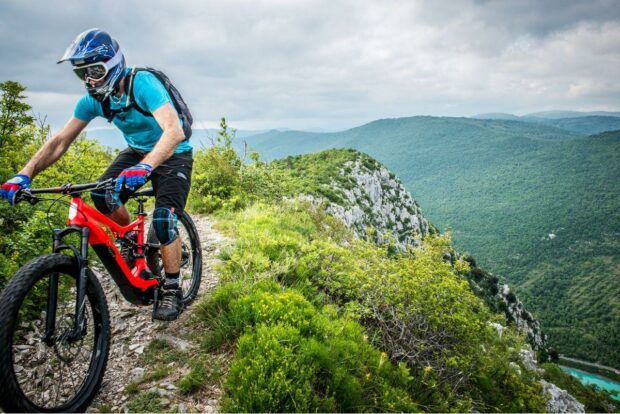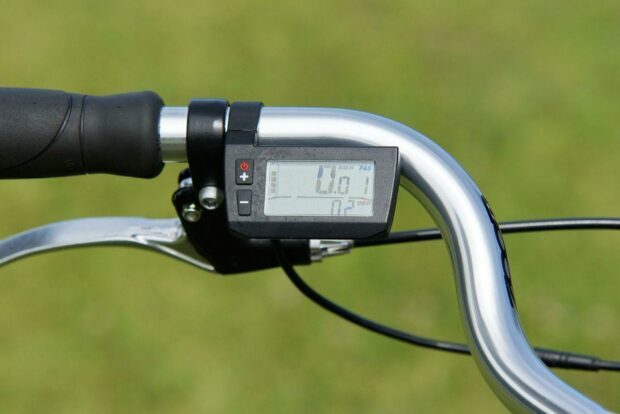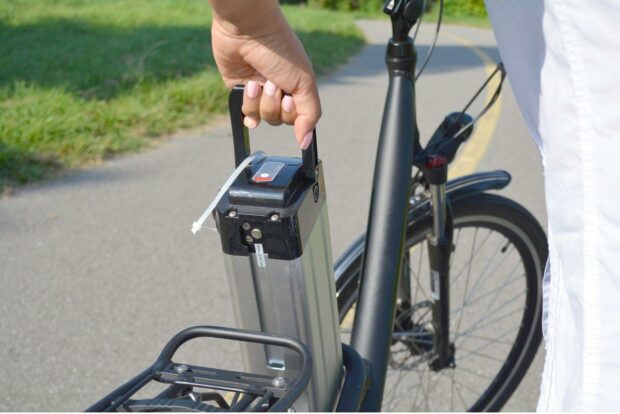Electric Thunder: Unleashing the Trail Revolution with Ebikes
The landscape of mountain biking has witnessed a significant metamorphosis in recent years, almost like a revolution charged by the forces of a storm, all thanks to the entry of a new contender; electric bicycles, popularly known as e-bikes. This ascent of e-bikes has altered the face of mountain biking, swapping the old panting and wheezing on challenging trails for a gentle electrical hum, as bikers now conquer terrains and slopes previously deemed insurmountable. But, the transformative power of e-bikes extends beyond the physical trails.

By providing a boost to the rider’s pedaling power, these high-tech electric fat tire bikes are leveling the field for a diverse range of enthusiasts, from seasoned athletes seeking to push their boundaries, to beginners desiring to explore the beauty of mountain trails without exhausting themselves. The democratizing effect of e-bikes has initiated a trail revolution, inspiring a wave of inclusivity that engulfs the entire mountain biking community, truly making it a game-changer in the world of outdoor sports.
Understanding E-bikes
E-bikes are just bicycles with an electric motor and a battery that assist the rider in pedaling. They comprise components such as a rechargeable battery, usually located on the frame, an electric motor for more power to the pedals, a controller that manages power output, and a drivetrain; a system similar to traditional bikes that translates your pedaling into motion.
Even though all bikes aren’t the same, there are two main types of e-bikes: pedal-assist and throttle-controlled. Pedal-assist e-bikes, also known as pedelecs, provide power only when you’re pedaling, to make the ride easier, especially up hills or against the wind. The power boost from the motor stops once you reach a certain speed, usually 20-28 mph, ensuring you still get a good workout.

Throttle-controlled e-bikes, in antithesis, work a bit differently. With a simple push of a button or twist of a handlebar-mounted throttle, these bikes can propel forward without any pedaling, much like a motorcycle or a scooter. However, most throttle e-bikes also offer a pedal-assist mode, giving riders the flexibility to pedal if they choose to.
Evolution of Mountain Biking
To truly appreciate the game-changing influence e-bikes have had on mountain biking, we must journey back to the very genesis of the sport. The birthplace of mountain biking harks back to the 1970s in Marin County, California, where a circle of biking enthusiasts started tweaking their bicycles to make them fit for downhill adventures on rugged mountain paths. These modified bikes, nicknamed “clunkers,” marked the humble beginnings of a sport that would captivate thrill-seekers around the globe.
The first major milestone in the evolution of mountain biking came in 1976 when Joe Breeze, one of those Marin County pioneers, built what is recognized as the first true mountain bike. His design dubbed the “Breezer #1,” incorporated a stronger frame, wider tires, and better brakes, setting the prototype for future mountain bikes.
From there, the sport grew rapidly. The first organized off-road bike race, the Repack Downhill, was held in 1976 in Fairfax, California, followed by the formation of the National Off-Road Bicycle Association in 1983, giving the sport a formal governing body.
Mountain biking made its Olympic debut in Atlanta in 1996, validating its place on the global sports stage. Each of these milestones contributed to the growth and development of mountain biking, creating a robust foundation for the subsequent e-bike revolution. It’s exciting to imagine where the next chapters in the evolution of this thrilling sport will take us, as the dawn of e-bikes continues to redefine the boundaries of trail exploration.
The Challenges Faced by Traditional Mountain Biking
Despite its thrilling appeal and passionate community, traditional mountain biking has faced several challenges that have restricted its accessibility and enjoyment for many. One of the most significant hurdles is the physical demand of the sport. Tackling steep inclines, uneven terrain, and long distances requires substantial stamina, strength, and cardiovascular fitness. These physical limitations have often made mountain biking daunting for beginners, those with fitness constraints, or older enthusiasts who may find the rigors of the sport taxing.

Also, the sport requires some technical skills that cannot be picked up overnight. Navigating rocky trails, mastering the balance on narrow paths, or executing safe descents are all skills that traditionally require practice and experience. This steep learning curve can be intimidating for novices, thereby posing accessibility issues.
The Emergence of E-bikes
The seed for the trail revolution we see today was sown with the introduction of electric motor technology in mountain biking. The concept was simple yet groundbreaking: blend the pedal power of a traditional bike with an electric motor’s assistance to make riding easier and more accessible. However, the journey of e-bikes from concept to reality wasn’t straightforward. It required vision, engineering prowess, and the willingness of a few brave pioneers to challenge the status quo.
We started seeing E-bikes in the late 1990s and early 2000s, but they were first made bulky, heavy, and lacked the necessary power for serious off-road use. It wasn’t until advancements in battery technology and motor efficiency in the late 2010s that e-bikes started to show real potential for mountain biking.
Early adopters of e-bikes in mountain biking were often individuals who saw the transformative potential of this technology. Trailblazers like Gary Fisher, one of the founding fathers of mountain biking, embraced the e-bike revolution early on. Recognizing their potential to break down barriers and make mountain biking more inclusive, these pioneers championed e-bikes despite facing initial skepticism from traditional biking communities.
Benefits of E-bikes for Mountain Bikers
E-bikes are a marvel of modern engineering that has brought a paradigm shift in mountain biking. They offer numerous benefits that include::
1. Enhanced Uphill Performance and Extended Range
One notable advantage of e-bikes is their capability to make uphill climbs easy. The added power from the electric motor kicks in precisely when you need it most, making ascents on steep mountain trails smoother and more manageable. This feature doesn’t just make riding more enjoyable; it also allows bikers to tackle trails that would have been too challenging on a traditional bike.

2. Empowering Riders of Different Fitness Levels
E-bikes have a leveling effect on the playing field, making mountain biking more accessible to individuals of different fitness levels. For beginners, older riders, or those recovering from injuries, the pedal-assist feature of e-bikes allows them to enjoy the thrill of the ride without overexerting themselves.
Conservation and Trail Management
While e-bikes undoubtedly offer tremendous advantages for mountain biking, they also present some concerns, particularly about trail conservation and environmental impact. Some argue that e-bikes, due to their motor assistance, might lead to increased trail usage, potentially causing more rapid trail erosion and disruption of wildlife habitats. However, it is still unsure if e-bikes indeed have a more significant environmental impact compared to traditional mountain bikes.
Addressing these concerns responsibly requires a collective effort from all stakeholders in the mountain biking community. Trail managers, biking associations, e-bike manufacturers, and riders themselves all have a crucial role to play in this regard.
Several collaborative efforts are also underway to establish responsible riding practices, including creating e-bike-specific trails or designating certain times for e-bike use on shared trails. Trail etiquette, such as yielding to other trail users and keeping speeds under control, is also being emphasized among e-bike riders to minimize potential conflicts.
E-bike manufacturers are also stepping up, producing lighter and more efficient models to lessen any potential adverse impact on trails. They’re also investing in research and trail maintenance initiatives to help keep the trails sustainable for future generations.
Controversies and Debates
Just like any game-changing innovation, the rise of e-bikes in mountain biking has stirred its share of controversies and debates. These stem from various myths and misconceptions surrounding e-bikes, as well as valid concerns from traditional mountain bikers and conservationists.
One common misconception is that e-bikes are “cheating” because they lessen the physical effort needed for biking. However, this perspective fails to recognize that e-bikes are just expanding the scope of who can enjoy mountain biking, without negating the opportunity for physical exertion.
Some traditional mountain bikers express concerns that e-bikes may change the spirit of the sport, turning serene trails into motorways. They should, however, note that the majority of e-bikes used for mountain biking are pedal-assist, not throttle-controlled, and their top speed is typically capped at a level that aligns with traditional biking speeds.
E-bike Technology and Innovations

The trail revolution we’re witnessing with e-bikes wouldn’t be possible without significant advancements in technology and innovative features that enhance the biking experience. Two primary areas of evolution in e-bike technology are battery and motor systems, and the integration of smart features and connectivity options.
Breakthroughs in Battery and Motor Technologies
The heart of an e-bike is its battery and motor system. The advent of lithium-ion batteries has revolutionized the e-bike industry. These batteries are lighter and last longer, and they pack a lot more power for their size compared to their predecessors. It’s safe to say they’ve been a real boon for e-bikes. These batteries provide the juice that helps bikers conquer steeper hills and travel longer distances without having to recharge.
The electric motors in e-bikes have also seen substantial improvements. They’ve become more efficient, quieter, and smaller while providing better power delivery. Some high-end e-bikes now feature sophisticated systems that adjust the level of assistance based on the rider’s input and the terrain’s steepness, ensuring a smooth and intuitive riding experience.
Integration of Smart Features and Connectivity Options
Another significant area of advancement is the integration of smart features and connectivity in e-bikes. A good number of today’s e-bikes come with digital screens that keep you updated with handy stats as you ride. You can glance down to check your speed, see how much battery you’ve got left, tally up the miles you’ve covered, and even monitor the level of help you’re getting from the motor. Some also feature integrated GPS systems for navigation and tracking rides.
We also now have some connectivity options like Bluetooth and Wi-Fi, which are increasingly common in e-bikes. These features allow riders to connect their e-bikes with smartphones, enhancing the riding experience with apps that provide ride data, route suggestions, and even maintenance reminders.
Riding Experience with E-bikes

Truly, E-bikes really offer a different riding experience. It’s like being on a conventional bike, yet it’s distinct in the sense of freedom, thrill, and unique aspects it brings to the trail. To further expand this experience, we gathered some common testimonials from hardcore riders and pro athletes.
One of the most frequently expressed sentiments from e-bike riders is the sense of empowerment they experience on the trails. The electric assist allows them to tackle routes they never thought possible, transforming uphill drudgery into something more akin to downhill thrill. In the words of professional mountain biker and e-bike enthusiast, Tracy Moseley, “E-bikes are all about access to those great places you’ve always wanted to ride.”
Another significant aspect of the e-bike riding experience is the extended range it offers. Pro rider Gary Fisher shares this excitement, stating, “With e-bikes, I can cover twice the ground in the same amount of time. It’s like having superpowers.”
E-bike converts often mention the sport’s inclusivity, noting that they can enjoy rides with friends or family members who might be at different fitness levels. As e-bike enthusiast and trail advocate, Susie Murphy puts it, “E-bikes level the playing field. Now I can enjoy a ride with my teenage kids without being left behind.”
Lastly, for many riders, the unique aspect of e-bike riding lies in its fun factor. There’s a simple joy in zipping up a hill with ease or extending a ride just because you have some battery power left. As professional athlete Geoff Kabush expresses, “E-bikes bring a whole new level of fun to mountain biking. It’s like being a kid again.”
Safety Considerations
Despite the exciting opportunities e-bikes bring to mountain biking, it’s essential to keep safety at the forefront. Firstly, speed limits and regulations are crucial. Most e-bikes are limited to providing assistance up to certain speeds, typically around 20 mph or 32 km/h, beyond which the motor won’t provide further aid. This limit is often in line with local laws and regulations, which e-bike riders should familiarize themselves with.
Protective gear is equally important when riding e-bikes, as it is with traditional bikes. Helmets are a must, and they should comply with safety standards. Additional protective gear like gloves, knee pads, and elbow pads are also recommended, especially when riding on more challenging terrain. Reflective gear and lights are also essential when riding in low-light conditions.
those gearing up to take their e-bikes out on the trails should make sure everything’s running smoothly. This includes a careful check of your brakes and tires, along with a thorough inspection of your battery and motor system. It’s all about ensuring a safe and enjoyable ride. Keeping safety at the core of the riding experience ensures that the thrill of e-bike mountain biking can be enjoyed responsibly and sustainably.
Challenges and Limitations of E-bikes

Despite the significant advantages e-bikes bring to mountain biking, they aren’t without their own set of challenges and limitations:
Battery Life and Charging Infrastructure Concerns
Battery life is one of the primary concerns with e-bikes. Riders need to plan their adventures carefully to ensure they won’t run out of power mid-trail. While battery technology is continuously improving, offering longer ranges and shorter charging times, it’s still a consideration that traditional bikes don’t have. Additionally, the lack of charging infrastructure in remote biking locations can pose challenges for extended e-bike rides. Although some trailheads and biking centers are beginning to install charging stations, widespread availability is still a work in progress.
Technical Difficulties and Maintenance Requirements
E-bikes, with their advanced technology and electronic components, also present unique maintenance requirements. Issues such as motor malfunctions or electrical system failures can be more complicated to fix than traditional bike repairs, often requiring specialized knowledge or professional assistance. Regular maintenance checks, especially for the battery and motor system, are necessary to keep the e-bike running smoothly. Moreover, e-bikes generally weigh more than traditional bikes, which can be a consideration when transporting them or maneuvering through particularly tricky terrain. Despite these challenges, the exhilarating experience of e-bike riding often makes these extra efforts worthwhile for many mountain biking enthusiasts.
Trail Advocacy and Legal Framework
Advocacy groups play a crucial role in promoting trail access for e-bikes, bridging the gap between e-bike enthusiasts and regulatory bodies. Groups like PeopleForBikes and the International Mountain Bicycling Association (IMBA) work tirelessly to engage with policymakers and the public, advocating for fair access to trails and promoting responsible e-bike usage. Their work is needed for advocating for e-bikes to be acknowledged as a bona fide facet of the mountain biking world. They play a major role in molding policies that promote both inclusivities among riders and sustainability within the sport.
Simultaneously, understanding the laws and regulations governing e-bike usage on trails is crucial for riders. These regulations can vary widely by region and can be influenced by factors such as the type of e-bike (pedal-assist or throttle-controlled), the bike’s maximum speed, and the classification of the trail. Some trails may have specific times for e-bike use, while others may designate certain routes for e-bikes. Staying informed and respectful of these laws not only helps ensure safety but also contributes to positive relationships between e-bike riders, traditional bikers, and trail conservationists.
Competitive E-biking
As e-bikes grow in popularity and acceptance, they’re also intruding on the competitive scenes. The rise of electric mountain bike races and competitions worldwide is evidence of this emerging trend. Events such as the Bosch eMTB Challenge and the UCI E-Mountain Bike World Championships are giving e-bikers the chance to test their skills and endurance against other e-bike enthusiasts. These events bring together a diverse group of riders – from seasoned professionals to novices – all keen to take part in this exhilarating new form of competitive mountain biking.
Adaptations in race formats and categories have been essential to accommodate e-bikes in the world of competitive mountain biking. Races often involve stages that test both technical skills and battery management, adding an additional strategic element compared to traditional bike races. Categories are usually divided based on the type of e-bike and sometimes the age or skill level of the riders. As e-bike technology continues evolving, it’s likely that we’ll see more innovations and developments in competitive e-biking.
Social Impact and Community Engagement
E-bikes aren’t just transforming the way we ride trails; they’re also creating a sense of togetherness among riders. All around the world, e-bike clubs and communities are popping up, offering riders a place to meet, exchange stories, and encourage mindful riding. These communities often organize group rides, maintenance workshops, and informative sessions about e-bike regulations and trail etiquette, contributing to the development of a well-informed and responsible e-biking culture.
Moreover, e-bikes are fostering inclusivity in the mountain biking world. Events and initiatives dedicated to welcoming new riders of various fitness levels, age groups, and abilities are becoming more common, thanks to the accessibility that e-bikes offer. You’ll find special e-bike gatherings, including rides for families, women, and seniors, becoming a common sight in many communities. These events not only make mountain biking more accessible to everyone but also help to knit together stronger social bonds among riders, cementing the notion that the trail is for all to enjoy. As we cycle forward into the future of mountain biking, it’s evident that e-bikes are at the heart of fostering a sense of community and inclusivity within the sport.
Environmental Sustainability

In the broader context of environmental sustainability, e-bikes present a compelling proposition. As a greener alternative to traditional modes of transportation, e-bikes hold the potential to significantly reduce our carbon footprint. For short commutes and recreational travel, they present an efficient alternative to gas-powered vehicles, using significantly less energy per mile. Furthermore, the electricity that powers e-bikes can come from renewable sources, making their operation potentially carbon-neutral.
E-bikes also play a part in promoting eco-friendly practices among riders. E-bikes spark a love for the great outdoors and a deeper bond with nature, often leading to heightened environmental consciousness. Plus, manufacturers of e-bikes are shifting gears towards environmental sustainability, focusing on greener production methods, batteries that go the distance, and materials that can be recycled. While challenges such as responsible battery disposal and energy consumption for battery production remain, the e-bike movement, by nature, aligns with a larger global effort to reduce carbon emissions and promote eco-friendly practices. The future of mountain biking, propelled by the electric thunder of e-bikes, is not only exciting but also holds promise for a more sustainable world.
Future of E-bikes in Mountain Biking
The future of e-bikes in mountain biking looks as thrilling as a high-speed downhill trail. Advancements in battery technology, motor efficiency, and integration of smart features are on the horizon, promising to further enhance the e-bike experience. Lighter frames, longer battery life, and more responsive pedal-assist systems are likely developments. Adoption rates are projected to increase as awareness grows, technology improves, and prices become more accessible. The projected expansion of the worldwide e-bike market certainly speaks volumes about this trend, hinting at e-bikes becoming an ever-more substantial slice of the broader bicycle market pie.
The potential influence of e-bikes on the culture and nature of the sport is substantial. As e-bikes become a more common sight, they’re set to continue molding the face of mountain biking, nurturing an even more varied and welcoming community of riders. Their influence may lead to more trail development, adapted to accommodate both traditional and e-bikes. Additionally, we might expect to see increased recognition of e-bikes in competitive events, with more categories and races dedicated to electric mountain biking. While some challenges and controversies will undoubtedly arise along the way, the e-bike revolution in mountain biking seems set to continue full speed ahead, leaving an indelible mark on the sport and its culture.
Summary and Conclusion
The transformative power of e-bikes on mountain biking is undeniable. They’ve revolutionized the sport, broadened its appeal, and sparked a trail revolution, changing the way we interact with nature and our communities. Peering into the future, there’s no doubt that e-bikes will keep on taking center stage, sculpting the contours of the mountain biking world.. So, now is the perfect time to embrace the e-bike revolution and unleash the electric thunder on the trails!
FAQs
Are e-bikes allowed on all mountain biking trails?
No, e-bikes are not allowed on all mountain biking trails. The rules vary by location and can depend on factors such as local laws, the type of e-bike, and trail designations.
How do e-bikes affect the physical fitness aspect of mountain biking?
E-bikes still provide a substantial workout, even though they assist with pedaling. You can adjust the level of assistance to match your fitness goals. Plus, e-bikes often encourage longer rides, which can lead to more overall physical activity.
Can I convert my traditional mountain bike into an e-bike?
Yes, it’s possible to convert a traditional mountain bike into an e-bike with a conversion kit. These kits typically include a motor, battery, and controller.
What are the main differences between pedal-assist and throttle-controlled e-bikes?
Pedal-assist e-bikes provide power only when you’re pedaling, and the amount of assistance typically depends on your pedaling speed and force. On the other hand, throttle-controlled e-bikes deliver power on demand at the push of a button or twist of a throttle, regardless of whether you’re pedaling.
How long does an e-bike battery last, and how do I charge it?
The battery life of an e-bike depends on the battery’s capacity, the terrain, the rider’s weight, and the level of motor assistance used. On average, you can expect between 20 to 50 miles of riding on a single charge. To charge it, you simply plug the charger (which comes with the e-bike) into a standard electrical outlet and connect it to the charging port on the battery. Most e-bike batteries take between 3 to 6 hours to fully charge.
Are there any age restrictions or licensing requirements for riding an e-bike?
Laws regarding e-bikes vary by location. In some places, you must be at least a certain age to ride an e-bike, while others may require a driver’s license, insurance, and helmet use.
What are the safety precautions to consider when riding an e-bike?
Safety precautions for e-bikes are similar to those for regular bikes: wear a helmet, use lights and reflectors if riding in low-light conditions, follow local traffic rules, and maintain your bike properly.
How do e-bikes contribute to trail conservation and management?
E-bikes can contribute to trail conservation by dispersing use across a wider network of trails, reducing the impact on any one trail. They also allow riders to climb steep hills more efficiently, which can reduce trail erosion caused by skidding.
Are there any professional competitions or races dedicated to e-biking?
Yes, there are professional races and competitions dedicated to e-biking, such as the Bosch eMTB Challenge and the UCI E-Mountain Bike World Championships.
What is the expected future development of e-bikes in the mountain biking industry?
Future developments in the e-bike industry are likely to focus on improving battery technology, enhancing motor efficiency, and integrating smart features for an improved riding experience. In the mountain biking industry, we can expect a rise in the popularity of e-bikes, leading to more e-bike-specific trails, races, and technological advancements tailored to the needs of off-road e-bike riders.
